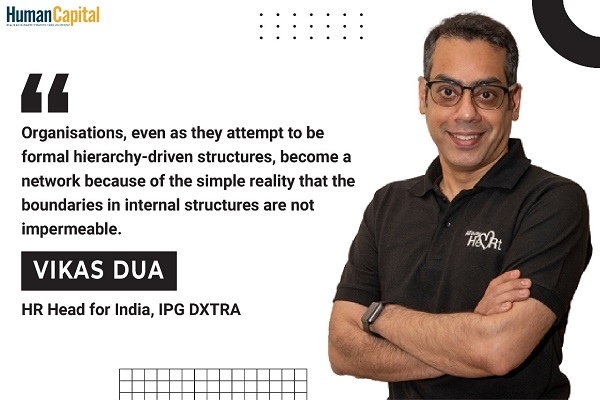The seeds of hybrid working model were sown many years ago. However, it took a crisis like COVID-19 for such a model to emerge as a reality.
‘The future is already here - it is just not evenly distributed’ – William Gibson
On a chilly winter evening in December in 2011, I was seated with my colleagues and was watching the breath-taking performances of one of the most expensive shows of Cirque du Soleil. This was an evening out in Paris; part of an official get-together of the team of fairly junior, non-client facing staff, and spread over four continents and fifteen countries. This was a bi-annual team meeting, that happened at various locations in Europe. If you are wondering how this organisation could afford these seemingly expensive offsites, with luxurious shows and dinners thrown in- your question is well placed. The answer lies in its unique business model. A model that supported remote work, brought in specialist workers from across the globe; working for a common purpose. This was the genesis of what today, has come to be called ‘the Hybrid Organisation!’ The seeds of this model were sown many years ago. However, it took a crisis like COVID-19 for such a model to emerge as a reality. Like they say, ‘the future is already here - it is just not evenly distributed’.
So, what is a hybrid organisation? “It is a company or a team with a few employees who are co-located and some others who work remotely, which is also referred to as “hybrid-remote.” There are three fundamental shifts that underpin today’s hybrid working model:
♦ Work is about the outcomes, not the work:
The advent of the multiplex transformed the movieviewing experience for an entire generation, who were used to the ‘three shows only’ scenario. Similarly, the hybrid working model has rendered the work concept of 9 A.M. to 5 P.M. redundant. It is not about the hours that you spend working, it is about the work that you do in those hours.
The concept of long working hours still exists, but the hours have changed. You could call the two hours in the evening as your ‘Do not disturb hours’- and choose to go for a painting class, so long as you compensate for those hours. The core point is that as an employee, you will be measured for the outcome of your tasks, not the tasks themselves.
♦ Work is about subcultures, not culture:
Today, there is no ‘one company culture’. In fact, several subcultures exist simultaneously. These subcultures are a great way to unite people with their common interests. Professionals join to celebrate their passions and learn more about their preferred way of living. The concept of the community- a smaller set of people that you will go to, is slowly becoming the order of the day.
These positive shifts notwithstanding, the hybrid working model may, in fact, prove to be difficult to adopt. More than the technology and the tools, the real shift is required to happen in the mind of the working employee. Here are a few reasons why this may not be as easy as it seems:
♦ Trust is in short supply:
The hierarchical Indian society thrives on the inherent belief that ‘all men are not made equal’. Caste, economic status, urbanrural, the reasons for demarcation are many and since everyone is not the same; not everyone can be trusted. In a hybrid work environment, where you cannot see half the people you work with, trust becomes the most important currency. The ability to trust requires an open mind. And to become trustworthy, you need to give more than you receive. In India, both these aspects seem to be in short supply.
♦ Emotional intelligence is a rare intelligence:
To be able to hear the tinge of sadness in the voice over a zoom call, or to read the frustration sitting between multiple email lines – requires a certain amount of sensitivity and awareness. When employees meet face to face, the emotions and the body language speak loud enough, but it is harder for most people to ‘see’ this over electronic media. As a result, unhappiness and disillusionment creep into our work lives, and goes unnoticed by almost everyone. And work continuously suffers.
♦ Performance management becomes a black hole:
With physically scattered team members, the role of the performance manager can be complex. The outcomes of the work must be so clearly defined or chunked such that it becomes easy for anyone to make an assessment. Work in the hybrid working model is like a relay race, with everyone picking up the baton hoping that the other runs just as fast. In reality, the chunking of work in such a manner is not always possible in a fluid, collaborative work environment.
♦ Flexibility is flexible:
How flexible is flexible? This can be an endless discussion depending on which side of the table you are on. You could be a team member who does not want to attend a morning meeting because you want to take the yoga class. As a manager, you insist on the morning meeting, because you have a doctor’s appointment for your mother in the evening. So, where does one draw the line? Besides, if schedules and timelines become flexible, then the concept of ‘EoD’ itself changes. So, is the hybrid working model not the ultimate panacea or the win-win for all? Well, it could be, if we, as leaders and team members, develop a few core skills that will help us thrive in this hybrid phygital future.
♦ Be the Master orchestrator:
The concept of bringing ‘one’s best version to work’ is passé. The hybrid working model will compel employees to bring their complete selves to work. After all, there is only one ‘you’. You cannot be a very different avatar at home and something else at work. Which means that as employees we will need to develop skills of a master orchestrator, stringing together the parent-teacher meetings and the client presentations to ensure the symphony of your life is beautiful.
♦ Become the purposeful executor:
It is very easy to lose focus and purpose in a hybrid work environment. For sure, there is no one physically breathing down your neck, but work needs to get done. This means to be successful; one will need to be high on execution, and also be purpose driven. Extrinsic motivation will help so much after that employees will need to search and harness their purpose to reach their full potential.
♦ Build the community:
The hybrid working model will make the world a smaller place and, in some way, make us go back to the basics. Just like in the preurbanisation era, people lived in communities, employees will align themselves to self-sufficient or likeminded communities. This will mean that we need to excel in communication because ‘reaching out’ will harder; but it is this skill that we will help grow.
♦ Make ‘kind and empathetic’ your middle name:
With one employee in Irkutsk in Russia and another in Zaragoza in Spain, team members will have no option but to adapt to different cultures, languages and time zones. This will mean that patience, gratitude and kindness need to become key work competencies. One will need to develop strong empathy and collaboration skills along with technical competence.
“…and He’s allowed me to go up to the mountain. And I’ve seen the Promised Land” says Abraham in the Book of Genesis. In many ways, the hybrid working model may be the promised land, with one important caveat. “Leave your country, your people and your father’s household”- said God in continuation. Similarly, we will need to leave our narrow definitions of work and workplace if we want to truly become inhabitants of the ‘promised land!’

Has COVID-19 forever changed the way we live and work?
Trending
-
SBI General Insurance Launches Digital Health Campaign
-
CredR Rolls Out 'Life Happens' Leave For Its Employees
-
Meesho Announces 30-Week Gender-Neutral Parental Leave Policy
-
Microsoft Unveils Tech Resilience Curriculum To Foster An Inclusive Future
-
60% Indian Professionals Looking For Job Change Due To COVID: Survey
-
SpringPeople And Siemens Collaborate For Digital Transformation Push
-
86% Professionals Believe Hybrid Work Is Essential For Work Life Balance: Report
-
Almost 1 In Every 3 People's Personal Life Affected Due To Work Stress
-
Meesho Rolls Out Reset And Recharge Policy For Employees
-
80% Of Talent Leaders & Academics Say Pandemic Changed Skill Needs For Youth: Report
-
Hero Electric Rolls Out 'Hero Care' Program For Employees
-
Human Capital In Collaboration With ASSOCHAM Hosts Virtual Conference
-
IKEA India, Tata STRIVE Collaborate To Create Employability And Entrepreneurship Opportunities
-
SAP India, Microsoft Launch Tech Skilling Program for Young Women
-
DXC Technology, NASSCOM Collaborate For Employability Skills Program
-
Lenskart To Hire Over 2000 Employees Across India By 2022
-
Mindtree Launches Learn-and-Earn Program
-
Tata AIA Extends 'Raksha Ka Teeka' To Its Employees
-
Swadesh Behera Is The New CPO Of Titan
-
NetConnect Global Plans To Recruit 5000 Tech Professionals In India
-
Hubhopper Plans To Hire 60% Of Indian Podcasters By 2022
-
Corporate India Needs More Women In Leadership Roles: Report
-
Aon to Invest $30 Million and Create 10,000 Apprenticeships by 2030
-
Tech Mahindra Launches ‘Gift a Career’ Initiative for Upskilling of Youth
-
40% Women Prefer Flexible Working Options in Post-COVID World: Survey
-
3 out of 4 companies believe they can effectively hire employees virtually: Report
-
Vodafone , CGI and NASSCOM Foundation launch digital skills platform
-
Odisha: Bank, postal employees to deliver cash for elderly, differently-abled persons
-
Skill India launches AI-based digital platform for "Skilled Workforce"
-
Hiring activity declines 6.73% in first quarter: Survey
-
70% startups impacted by COVID-19 pandemic
-
Bajaj Allianz Life ropes in Santanu Banerjee as CHRO
-
Over 70 Percent MSMEs look at cutting jobs to sustain businesses
-
93 Per Cent employees stressed about returning to office post-lockdown
-
Johnson & Johnson India announces family benefits for same gender partners
-
Indian firms turning friendly towards working mothers
-
Welspun India names Rajendra Mehta as new CHRO
-
Wipro partners with NASSCOM to launch Future Skills platform



Human Capital is niche media organisation for HR and Corporate. Our aim is to create an outstanding user experience for all our clients, readers, employers and employees through inspiring, industry-leading content pieces in the form of case studies, analysis, expert reports, authored articles and blogs. We cover topics such as talent acquisition, learning and development, diversity and inclusion, leadership, compensation, recruitment and many more.
Subscribe Now












































Comment